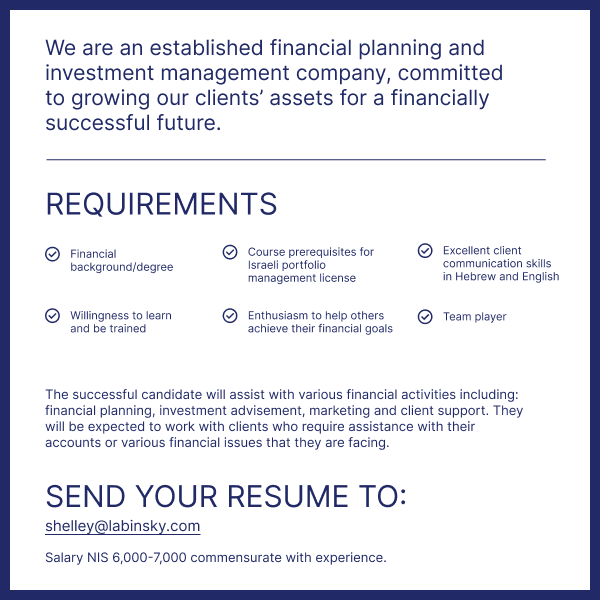Chances are that a fair percentage of those reading this article recently received a letter in Hebrew from Bituach Leumi – double-sided, tastefully highlighted in different shades of purple, and probably ignored by many Anglos … put in a pile of ‘things I’ll get to at some point’, or actually thrown in the garbage.
But that letter detailed a very important new savings program that the government is initiating in January 2017. Without going into any of the history and background that brought the government to this point, the following paragraphs outline the government-mandated savings plan that has been created for each of your children under the age of 18.
Basically, every single child in Israel will receive 50 nis per month until their 18th birthday. There will also be retroactive payments for the period from May 2015 until December 2016. When each child reaches 18 Bituach Leumi will give them an extra lump sum of 500 nis. If the savings are not withdrawn until the child turns 21, an additional grant of 500 nis will be deposited. Bituach Leumi has a full description of the program in English via the link http://haotzarsheli.mof.gov.il/Documents/english.pdf.
You need to make a few major decisions (before the June 1 2017 deadline) regarding each child’s account, and there are a few critical points that I want to emphasize. The two main decisions to make are:
- in which type of institution to deposit the savings
- in which investment track to place your child’s money.
For each account you have the choice of whether it should be managed by a bank or an investment house through a kupat gemel (long-term provident savings plan). The Bituach Leumi site (and the letter you received) details the list of banks and investment houses that are participating in the program.
This decision is major because you have to keep the account in whatever type of institution you choose until your child reaches 18. Transfers between investment houses are allowed, but you may not transfer between banks, and you cannot transfer from a bank to an investment house or vice versa. So if you choose to open the account with a bank it will stay there until the funds are withdrawn. The investment options with the banks are in an ultra-conservative savings account with its currently almost negligible interest rates (although those rates will change over time). The bank investment options are intrinsically more conservative because they guarantee your original capital with the addition of any small amounts of interest earned over the years. This bank track would mainly suit ultra-conservative investors, or children nearing 18 who anticipate withdrawing the funds in the short term, and cannot take the riskier option of a investing through a kupat gemel.
There are several savings tracks within the investment house/kupot gemel option, and you have the option to move between different tracks offering you greater flexibility over the years. You can decide on a conservative, medium risk or aggressive track, or tracks that adhere to stricter halachic standards when investing. Many parents should weigh-up starting off more aggressively and as your child gets closer to needing the money, you should consider changing tracks to a more conservative option.
Generally, accounts that will be set up for children, where the money will be invested for long periods of time that could last for a decade or even possibly decades, should under most circumstances be invested in a way that provides a better opportunity to see growth in the savings. Markets fluctuate in the short term. But historically stock markets have shown themselves to offer the best prospect for long term gain. And seeing as the money being invested is a pure gift, “free money” if you like from the government, it can provide an excellent basis for a significant savings account for each of your children.
Because the payments are made monthly, the investment risk levels are reduced. So for example, even if the market drops over a period of time, this drop provides an opportunity to invest the following month at the lower cost – a situation referred to as “dollar (in this case shekel) cost average investing”. This monthly investing significantly reduces your long term risk and is especially appropriate for long term investment accounts which you would like to follow a more aggressive investment approach.
There are different opinions regarding the halachic aspect of investments. If you feel this could be relevant to you check with your Rabbi regarding the advantages that this provides.
Capital gains will be paid on any profits earned upon the withdrawal of the savings. (Although if someone exercises extreme restraint and doesn’t touch the account until retirement age, they will be eligible to withdraw a monthly pension and avoid paying any tax at all on the account.)
Bituach Leumi is giving parents the option to match their 50 nis monthly deposit, essentially doubling the amount that will be saved. Obviously this is highly recommended. This 50 nis sum will be transferred from the monthly child benefit allowance you receive from Bituach Leumi. Although this extra sum will not offer you any major tax saving, it is always advisable to put away more money for your kids’ needs, and you may not even miss those amounts in your monthly budget, depending on how many 50 nis increments you are adding. And even if you will feel the difference, it offers a huge potential advantage for each of your children.
As I mentioned earlier in the article if your children can hold off withdrawing the money until they turn 21, they will get an additional lump sum of 500 nis, which is a very nice bonus rate of return for showing financial patience. And financial patience in itself is a great virtue which should be encouraged.
This government savings plan is an excellent double opportunity. Not only does it give every single child a savings plan of their own, but it is also an incredible educational tool – both for parents who will be administering a savings account for each child, but also for the children themselves to learn about finances. Involve your children in the plan and the options. Discuss with them the various tracks. Teach them how to make prudent decisions about what and how to invest.
The government is giving your children two great gifts. But the educational aspect is by far the more beneficial, as that has the potential to stand them in good stead throughout their adult life. Behatzlacha!










Leave a Reply